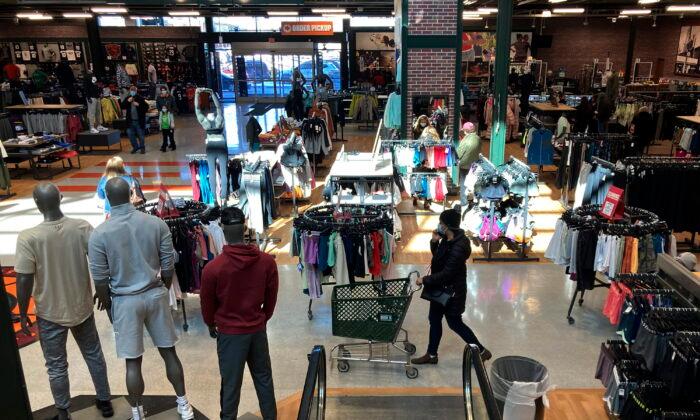U.S. retail sales rose 1 percent in June, largely due to higher prices for food and gas, led by inflation and not sales volumes, according to the Commerce Department on July 15.
Total Retail Sales Report
The total retail sales, excluding auto purchases, rose 0.4 percent in June and were unchanged on an annual basis. Economists had expected a 0.1 percent increase for the top-line number; instead it was flat year over year (in line with expectations). May’s gain of 1 percent was revised down to 0.8 percent. Retail sales excluding food and gas rose 0.7 percent from the previous month. The numbers are seasonally adjusted, but not for inflation. They also come during a month when the consumer price index was flat. As the price of gasoline dropped from its record high, sales at gas stations declined 1.8 percent. Motor vehicle and parts dealers also saw their sales fall sharply—down 1.6 percent from the previous month. National average gas prices peaked at $5.01 per gallon on June 14, but have since fallen to $3.79 a gallon for regular unleaded gasoline, as measured by AAA on Sept. 30.The report came after another release by the Labor Department on July 13 showing U.S. inflation up 9.1 percent in the 12 months ending in June.
On July 14, the department said that inflation at the wholesale level, before it reached consumers, increased 11.3 percent since June 2021.
Consumer spending nationwide last month increased more than had been expected, with many Americans still spending, despite high inflation.
Economists polled by The Wall Street Journal had forecast a 0.9 percent increase in retail sales, which have begun to flag since last month, after surging since the end of 2020.
Still, it is a contrast from May, when retail spending declined by 0.1 percent after Commerce initially reported sales dropping 0.3 percent for that month.
Retailers are dealing with the effects of high inflation, as customers are becoming more selective in their purchases, with chains like Target and Walmart offering huge discounts after ending up with a glut of inventory.
Many Americans have been spending less on clothes and retail and more on food and services.
Retail Store Sales in July
Despite inflation, consumers continued to shop in July, National Retail Federation reported.Internet retailers, big box stores, and home furnishing outlets reported an increase in sales, while home centers, clothing stores, and department stores all saw declines.
Online sales rose 2.2 percent, and furniture and home store sales were up 1.4 percent.
Brick-and-mortar sales fell, with general items down 0.2 percent due to a 2.6 percent decline in retail sales.
Gas prices, which were the greatest driver of inflation in the United States over the last 12 months, rose by almost 50 percent since June of last year, while food and drink prices rose 13.4 percent.
Gas station revenue jumped 3.6 percent in June, as the average cost of a gallon of gas topped $5 for the first time, but has fallen since the start of this month, offering drivers mild relief.
Higher energy prices did not stop a rise in vehicle and parts sales in June, which saw a 0.8 percent increase, as automakers sold more vehicles at higher prices.
When not taking gas and auto sales into account, retail sales were reduced to a 0.7 percent increase last month.
Meanwhile, a July 15 New York Fed report provided some positive news about manufacturing, with the Empire State Manufacturing Survey for July posting an 11.1 reading.
The U.S. economy has shown signs of slowing down over the last two quarters, adding pressure on the Federal Reserve to aggressively raise interest rates in order to combat inflation.Central bank policymakers are expected to approve another rate hike later this month that could hit a full percentage point, the largest such increase since 1994.
Fed governor Christopher Waller said that the retail sales report would be a key input in determining whether to hike rates by 75 or 100 basis points at the upcoming July 26–27 FOMC meeting.





